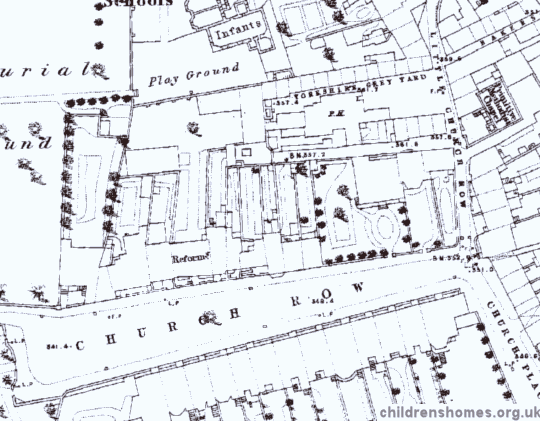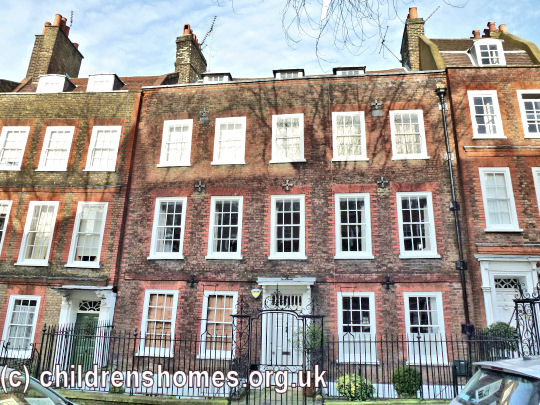Hampstead Reformatory for Girls, Hampstead, London
Following the decision by the Rescue Society to close its Reformatory for Girls at 28 Church Row, Hampstead, a group of interested gentlemen in the neighbourhood formed an association to open a replacement. The new institution, known as the Hampstead Reformatory for Girls, was located just a few doors away at 9 Church Row. The premises were officially certified to begin operation on December 29th, 1860. The inmates from No. 28 then moved in, along with Miss Christian Nicoll whose employment was taken over by the new committee.
The Reformatory site is shown on the 1871 map below.

Hampstead Reformatory for Girls site, Hampstead, c.1871.

Former Hampstead Reformatory for Girls, Hampstead, 2013. © Peter Higginbotham
The new premises comprised two adjacent houses with a large garden, and a stable and coach-house which were converted into a laundry. There was initially accommodation for 80 girls, with the number rising to nearly l00 after work on adapting the adjoining house was completed. Early inspection reports questioned the small number of staff employed at the establishment which in 1865 comprised a schoolmistress, two assistant teachers and two laundry matrons. It appears that Miss Nicoll took on duties normally consigned to assistants, and also trained the girls to perform many of the household and cooking duties. The girls were employed in washing and needlework, with the laundry generating some useful income for the institution.
An inspection report in 1873 commended the remarkable good order and moral tone of the institution. Knitting had now been added to the girls' industrial employment and the laundry work was being carried on a very extensive scale. It was also noted the management committee were planning to move the establishment to better location.
A new site was subsequently found in the shape of Heathfield House, a large property on Holford Road, at the southern edge of Hampstead Heath. After the new premises were officially certified on April 17, 1876, the girls and staff were transferred to their new home. The Church Row building was then taken over by Field Lane Industrial School for Girls, previously based at Clerkenwell.
The Heathfield House premises could accommodate up to 120 girls, who were aged from 10 to 16 at their date of admission. The operation of the Reformatory at its new location carried on very much as before. A large laundry had been constructed, where the older girls were employed, while the younger ones were occupied with cooking, housework, needlework and knitting. A setback occurred in 1877 when widespread dry-rot was discovered in the building's roof timbers which cost several hundred pounds to remedy.

Former Hampstead Reformatory for Girls, Hampstead, 2013. © Peter Higginbotham
Good order generally prevailed at the establishment until December 28th, 1886, when there was a serious outbreak of unruly conduct. Several of the older girls defied authority, used very bad language, and caused a great disturbance, attempting to excite the better-disposed girls into rebellion. Twelve of the ringleaders received prison sentences for their actions, and some of the rest were punished in the institution.
In 1890, the decline in the numbers being committed to the Reformatory, together with the declining health Miss Nicoll after more than 30 years as superintendent, led to a decision to close the institution. The closure formally took place on June 30th, 1891.
The property was subsequently renamed Melville Hall, then later became the Ladywell Nursing Home. Its is now in private residential use and known as Ladywell Court.
Records
Note: many repositories impose a closure period of up to 100 years for records identifying individuals. Before travelling a long distance, always check that the records you want to consult will be available.
- None identfied at present — any information welcome.
Bibliography
- Carpenter, Mary Reformatory Schools, for the Children of the Perishing and Dangerous Classes, and for Juvenile Offenders (1851, General Books; various reprints available)
- Carlebach, Julius Caring for Children in Trouble (1970, Routledge & Kegan Paul)
- Higginbotham, Peter Children's Homes: A History of Institutional Care for Britain's Young (2017, Pen & Sword)
- Abel Smith, Doroth Crouchfield: A History of the Herts Training School 1857-1982 (2008, Able Publishing)
- Garnett, Emmeline Juvenile offenders in Victorian Lancashire: W J Garnnett and the Bleasdale Reformatory (2008, Regional Heritage Centre, Lancaster University)
- Hicks, J.D. The Yorkshire Catholic Reformatory, Market Weighton (1996, East Yorkshire Local History Society)
- Slocombe, Ivor Wiltshire Reformatory for Boys, Warminster, 1856-1924 (2005, Hobnob Press)
- Duckworth, J.S. The Hardwicke Reformatory School, Gloucestershire (in Transactions of the Bristol and Gloucestershire Archaeological Society, 1995, Vol. 113, 151-165)
Links
- Red Lodge Museum, Bristol — a former girls' reformatory.
Except where indicated, this page () © Peter Higginbotham. Contents may not be reproduced without permission.


